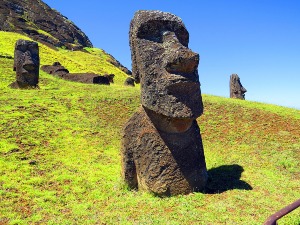
Around 800 years ago, Easter Island’s colossal human-like statues were sculpted by the island’s early inhabitants. These statues have fueled decades worth of research to solve their mysteries: why were they created and how did they end up in their locations?
The statues, called
moai
, weigh up to 92 tons and have puzzled scientist in their search for answers about their properties, usage, and importance. Typically, these
moai
monuments are settled atop platforms called
ahu
where they are displayed near the coasts of the island. However, these complementary items did not always have a chance to pair up.
According to Carl Lipo, an anthropologist at Binghamton University, you can have
ahu
without
moai
and
moai
without
ahu
, especially along the roads on which the
moai
were being transported to the
ahu
; they just never successfully reached their destinations.
One major element scientists have always pondered lies in the understanding of how these massive monuments were transported. To test out possible methods of transportation, in 2012, Lipo and his fellow researcher, Terry Hunt from the University of Arizona, conducted an experiment which showed that
moai
could be moved with rope and just over a dozen people.
In their experiment with 18 people, they managed to move a ten-foot, five-ton
moai
a few hundred yards by using three durable ropes and implementing a rocking technique to shift the structure. To add on to the study, Lipo hypothesized last year that red hats weighing up to 13 tons were possibly added atop the statues using ropes to roll the mass up a ramp.
Today, Lipo’s study focuses on the mystery of why the statues exist in their specific positions and locations. A recent paper published by PLOS One suggests that statue placements were chosen based on the presence and availability of fresh water in the area.
This idea was proposed after the realization that the monuments exist in locations contrary to areas ideal for
ahu
and ritualistic practices. For instance, if the purpose of the structures were symbolic and honorary, one would assume these monuments would be displayed in higher regions for greater public view. However, this is far from reality; the sculptures congregate near coasts in sporadic groups making it clear that the early islanders had other reasons for their selected sculpture placements.
On Easter Island, fresh water is an incredibly scarce and valued resource. During his time on the island, Lipo examined how fresh water might impact settlement as he discovered a correlation between these factors during a previous study in Hawaii. At that time, he found that the volcanic islands of Hawaii demonstrate a peculiar feature where fresh water enters oceans by traveling through volcanic tubes. Local Hawaiians like fishermen in the area are aware of this phenomenon. Using this information, Lipo and his graduate student co-author, Tonya Broadman, decided to see if the same features played out on the Easter Islands: they did.
“At low tide, when the saltwater’s down, fresh water pours right out at the coast,” he stated. With additional investigation into the island’s historical European settlements, Lipo confirmed the same phenomenon occurred during the time early islanders were present.
To continue the investigation, Lipo and Broadman pinpointed and mapped locations of fresh water sources across the island. With this mapping and quantitative spatial modeling, they discovered that these freshwater locations also had
ahu
.
“The freshwater location is the strongest component of determining the location of
ahu
and
moai
, more so than any of the other factors,” based on data analysis. For decades, researchers have hypothesized about the relationship between natural resources and the
ahu
or
moai
constructions. However, this has been the first time data has been collected to quantitatively support the relationship.
Lipo and his crew of researchers plan to revisit Easter Island in May to collect more data and further study the construction of
ahu
and
moai
. “We may never get an [definitive] answer because people had a lot of reasons for making statues”. However, the understanding of Easter Island and its statues will create an archive knowledge about its early inhabitants and their ways of life.
[Source:
arstechnica.com
]

